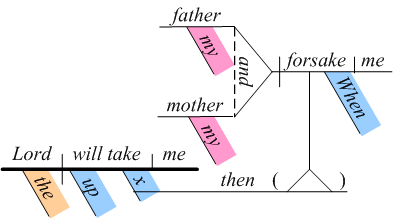« Two Pineapple Grenades | Main | Your Sky Updated »
Saturday, January 13, 2007
Reading List: Sister Bernadette's Barking Dog
- Florey, Kitty Burns. Sister Bernadette's Barking Dog. Hoboken, NJ: Melville House, 2006. ISBN 1-933633-10-7.
-
In 1877, Alonzo Reed and and Brainerd Kellogg published Higher
Lessons in English, which introduced their system for the
grammatical diagramming of English sentences. For example, the
sentence “When my father and my mother forsake me, then the Lord
will take me up” (an example from Lesson 63 of their book)
would be diagrammed as:

Diagram by Bruce D. Despain.
Posted at January 13, 2007 22:44